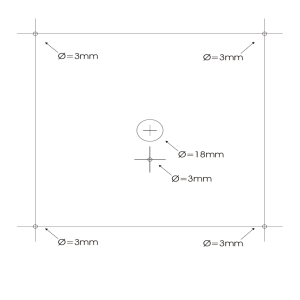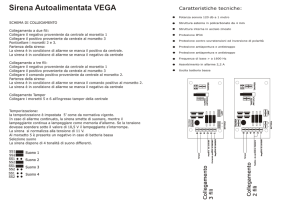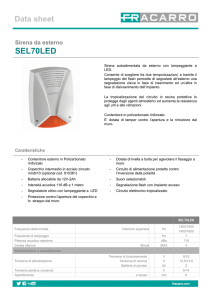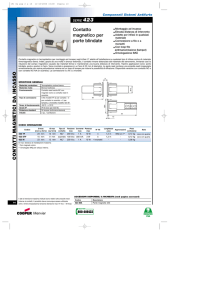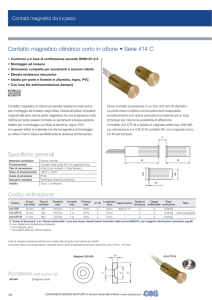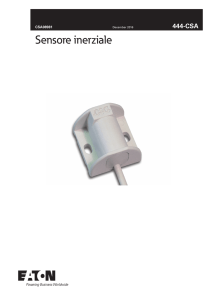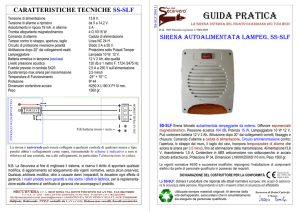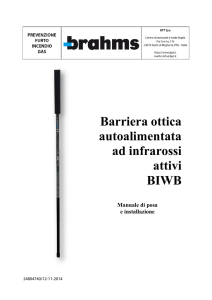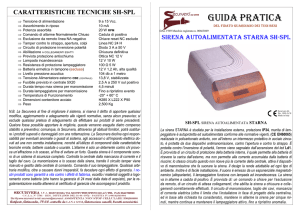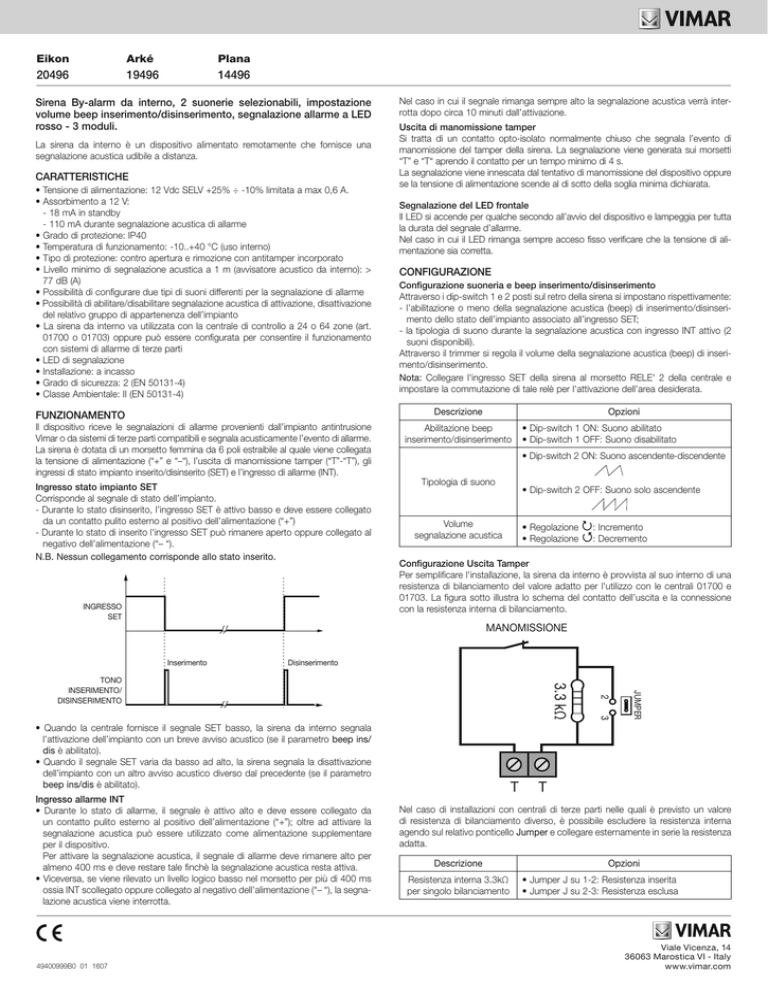
Eikon
Arké
Plana
20496
19496
14496
Sirena By-alarm da interno, 2 suonerie selezionabili, impostazione
volume beep inserimento/disinserimento, segnalazione allarme a LED
rosso - 3 moduli.
La sirena da interno è un dispositivo alimentato remotamente che fornisce una
segnalazione acustica udibile a distanza.
CARATTERISTICHE
• Tensione di alimentazione: 12 Vdc SELV +25% ÷ -10% limitata a max 0,6 A.
• Assorbimento a 12 V:
- 18 mA in standby
- 110 mA durante segnalazione acustica di allarme
• Grado di protezione: IP40
• Temperatura di funzionamento: -10..+40 °C (uso interno)
• Tipo di protezione: contro apertura e rimozione con antitamper incorporato
• Livello minimo di segnalazione acustica a 1 m (avvisatore acustico da interno): >
77 dB (A)
• Possibilità di configurare due tipi di suoni differenti per la segnalazione di allarme
• Possibilità di abilitare/disabilitare segnalazione acustica di attivazione, disattivazione
del relativo gruppo di appartenenza dell’impianto
• La sirena da interno va utilizzata con la centrale di controllo a 24 o 64 zone (art.
01700 o 01703) oppure può essere configurata per consentire il funzionamento
con sistemi di allarme di terze parti
•LED di segnalazione
•Installazione: a incasso
• Grado di sicurezza: 2 (EN 50131-4)
• Classe Ambientale: II (EN 50131-4)
Nel caso in cui il segnale rimanga sempre alto la segnalazione acustica verrà interrotta dopo circa 10 minuti dall’attivazione.
Uscita di manomissione tamper
Si tratta di un contatto opto-isolato normalmente chiuso che segnala l’evento di
manomissione del tamper della sirena. La segnalazione viene generata sui morsetti
“T” e “T“ aprendo il contatto per un tempo minimo di 4 s.
La segnalazione viene innescata dal tentativo di manomissione del dispositivo oppure
se la tensione di alimentazione scende al di sotto della soglia minima dichiarata.
Segnalazione del LED frontale
Il LED si accende per qualche secondo all’avvio del dispositivo e lampeggia per tutta
la durata del segnale d’allarme.
Nel caso in cui il LED rimanga sempre acceso fisso verificare che la tensione di alimentazione sia corretta.
CONFIGURAZIONE
Configurazione suoneria e beep inserimento/disinserimento
Attraverso i dip-switch 1 e 2 posti sul retro della sirena si impostano rispettivamente:
- l’abilitazione o meno della segnalazione acustica (beep) di inserimento/disinserimento dello stato dell’impianto associato all’ingresso SET;
- la tipologia di suono durante la segnalazione acustica con ingresso INT attivo (2
suoni disponibili).
Attraverso il trimmer si regola il volume della segnalazione acustica (beep) di inserimento/disinserimento.
Nota: Collegare l'ingresso SET della sirena al morsetto RELE' 2 della centrale e
impostare la commutazione di tale relè per l'attivazione dell'area desiderata.
Descrizione
FUNZIONAMENTO
Il dispositivo riceve le segnalazioni di allarme provenienti dall’impianto antintrusione
Vimar o da sistemi di terze parti compatibili e segnala acusticamente l’evento di allarme.
La sirena è dotata di un morsetto femmina da 6 poli estraibile al quale viene collegata
la tensione di alimentazione (“+” e “–“), l’uscita di manomissione tamper (“T”-“T”), gli
ingressi di stato impianto inserito/disinserito (SET) e l’ingresso di allarme (INT).
Ingresso stato impianto SET
Corrisponde al segnale di stato dell’impianto.
- Durante lo stato disinserito, l’ingresso SET è attivo basso e deve essere collegato
da un contatto pulito esterno al positivo dell’alimentazione (“+”)
- Durante lo stato di inserito l'ingresso SET può rimanere aperto oppure collegato al
negativo dell’alimentazione (“– “).
N.B. Nessun collegamento corrisponde allo stato inserito.
INGRESSO
SET
Opzioni
Abilitazione beep
inserimento/disinserimento
• Dip-switch 1 ON: Suono abilitato
• Dip-switch 1 OFF: Suono disabilitato
• Dip-switch 2 ON: Suono ascendente-discendente
Tipologia di suono
• Dip-switch 2 OFF: Suono solo ascendente
Volume
segnalazione acustica
• Regolazione : Incremento
• Regolazione : Decremento
Configurazione Uscita Tamper
Per semplificare l'installazione, la sirena da interno è provvista al suo interno di una
resistenza di bilanciamento del valore adatto per l'utilizzo con le centrali 01700 e
01703. La figura sotto illustra lo schema del contatto dell’uscita e la connessione
con la resistenza interna di bilanciamento.
MANOMISSIONE
Inserimento
Disinserimento
49400999B0 01 1607
T
JUMPER
Ingresso allarme INT
• Durante lo stato di allarme, il segnale è attivo alto e deve essere collegato da
un contatto pulito esterno al positivo dell’alimentazione (“+”); oltre ad attivare la
segnalazione acustica può essere utilizzato come alimentazione supplementare
per il dispositivo.
Per attivare la segnalazione acustica, il segnale di allarme deve rimanere alto per
almeno 400 ms e deve restare tale finchè la segnalazione acustica resta attiva.
• Viceversa, se viene rilevato un livello logico basso nel morsetto per più di 400 ms
ossia INT scollegato oppure collegato al negativo dell’alimentazione (“– “), la segnalazione acustica viene interrotta.
3
• Quando la centrale fornisce il segnale SET basso, la sirena da interno segnala
l’attivazione dell’impianto con un breve avviso acustico (se il parametro beep ins/
dis è abilitato).
• Quando il segnale SET varia da basso ad alto, la sirena segnala la disattivazione
dell’impianto con un altro avviso acustico diverso dal precedente (se il parametro
beep ins/dis è abilitato).
2
3.3 kΩ
TONO
INSERIMENTO/
DISINSERIMENTO
T
Nel caso di installazioni con centrali di terze parti nelle quali è previsto un valore
di resistenza di bilanciamento diverso, è possibile escludere la resistenza interna
agendo sul relativo ponticello Jumper e collegare esternamente in serie la resistenza
adatta.
Descrizione
Resistenza interna 3.3kΩ
per singolo bilanciamento
Opzioni
• Jumper J su 1-2: Resistenza inserita
• Jumper J su 2-3: Resistenza esclusa
Viale Vicenza, 14
36063 Marostica VI - Italy
www.vimar.com
Eikon
Arké
Plana
20496
19496
14496
Il massimo carico comandabile con l’uscita Tamper è pari a 250 mA 24 V resistivi.
N.B.: Nel caso di collegamento di più sirene in serie verso i morsetti T T della centrale
soltanto una di queste sirene dovrà avere la resistenza inserita.
COLLEGAMENTI
• Le connessioni filari dell’impianto antintrusione vengono fissati su un apposito
connettore femmina estraibile (che facilita l’installazione) e si innesta nel connettore maschio nel retro del dispositivo. Lo schermo del cavo va collegato solo in
centrale assieme al conduttore negativo dell’alimentazione.
• Separare l'alimentazione della sirena da quella dei rivelatori.
• E’ necessario che gli ingressi della centrale siano correttamente configurati con lo
stesso significato delle uscite del dispositivo.
• L’ingresso SET genera la breve segnalazione acustica in funzione dell’inserimento o meno di un gruppo a scelta. E’ necessario che all’uscita della centrale sia
assegnato il gruppo interessato.
• Nelle centrali di controllo 01700 e 01703 si utilizza il contatto NC del Relè 2 che,
a stato disinserito, si chiude sul positivo dell’alimentazione.
• Sui moduli d’espansione uscita va collegato allo stesso modo utilizzando i due
morsetti del contatto relè dell’uscita configurata.
• L’uscita del dispositivo apre e chiude un contatto per cui la polarità di collegamento al relativo ingresso è indifferente.
Per le tipologie di collegamento si vedano le figure COLLEGAMENTI CON LA
CENTRALE.
REGOLE DI INSTALLAZIONE
• L’installazione deve essere effettuata con l’osservanza delle disposizioni regolanti l’installazione del materiale elettrico in vigore nel paese dove i prodotti sono
installati.
• Nell'installazione del rivelatore in scatole da incasso, per garantire la protezione
contro l'apertura e la rimozione, utilizzare esclusivamente supporti 3 moduli fissati
con le 2 viti anti-manomissione fornite in dotazione alla sirena. In tal caso, l'eventuale disinstallazione della sirena dovrà essere eseguita agendo con un cacciavite
sui 4 denti di aggancio.
• Non installare su pareti mobili o soggette a urti e vibrazioni.
• Per l’installazione utilizzare cavi schermati esenti da alogeni idonei per installazione con cavi energia di I Categoria (U0 = 400 V) VIMAR 01734 (2x0,50mm2 +
4x0,22mm2).
• La lunghezza dei collegamenti non deve superare i 100 m.
CONFORMITA' NORMATIVA
By-alarm siren for indoor use, 2 selectable ringtones, on/off beep
volume setting, alarm signalling with red LED - 3 modules.
The siren for indoor use is a remotely powered device that provides an acoustic
signal that is audible from a distance.
CHARACTERISTICS
• Supply voltage: 12 Vdc SELV +25% to -10% limited to max 0.6 A.
• Absorption at 12 V:
- 18 mA on standby
- 110 mA during audible alarms
• Protection class: IP40
• Operating temperature: -10..+40 °C (indoor use)
• Type of protection: against opening and removal with anti-tamper device built in
• Minimum level of audible warning at 1 m (acoustic alarm for indoor use): > 77 dB (A)
• Possibility of configuring two different types of sound for alarm signalling
• Possibility of enabling/disabling acoustic signalling of activation, deactivation of
the relevant system group
• The siren for indoor use must be used with the 24 or 64 zone control panel (art.
01700, 01700.120 or 01703, 01703.120) or it can be configured to allow operation with third-party alarm systems
•Indicator LED
•Installation: flush mounting
• Degree of safety: 2 (EN 50131-4)
• Ambient class: II (EN 50131-4)
OPERATION
The device receives the alarm signals coming from the Vimar burglar alarm system
or from compatible third-party systems and acoustically signals the alarm event.
The siren is equipped with a removable 6-pole female terminal which is connected
to the supply voltage ("+" and "–"), tamper output ("T"-"T"), on/off system status
inputs (SET) and the alarm input (INT).
SET system status input
Corresponds to the system status signal.
- When off, the SET input is on low and must be connected by an external voltage
free contact to the positive terminal of the power supply (“+”)
- When on, the SET input can stay open or be connected to the negative terminal
of the power supply (“– “).
N.B. No connection corresponds to the state of being on.
EN 50131-4.
Direttiva EMC.
Norme EN 50130-4, EN 61000-6-3.
RAEE - Informazione agli utilizzatori
Il simbolo del cassonetto barrato riportato sull’apparecchiatura o sulla
sua confezione indica che il prodotto alla fine della propria vita utile deve
essere raccolto separatamente dagli altri rifiuti. L’utente dovrà, pertanto,
conferire l’apparecchiatura giunta a fine vita agli idonei centri comunali
di raccolta differenziata dei rifiuti elettrotecnici ed elettronici. In alternativa alla gestione autonoma è possibile consegnare l’apparecchiatura
che si desidera smaltire al rivenditore, al momento dell’acquisto di una
nuova apparecchiatura di tipo equivalente. Presso i rivenditori di prodotti
elettronici con superficie di vendita di almeno 400 m2 è inoltre possibile
consegnare gratuitamente, senza obbligo di acquisto, i prodotti elettronici da smaltire con dimensioni inferiori a 25 cm. L’adeguata raccolta
differenziata per l’avvio successivo dell’apparecchiatura dismessa al
riciclaggio, al trattamento e allo smaltimento ambientalmente compatibile contribuisce ad evitare possibili effetti negativi sull’ambiente e sulla
salute e favorisce il reimpiego e/o riciclo dei materiali di cui è composta
l’apparecchiatura.
49400999B0 01 1607
INPUT
SET
ON
OFF
TONE
ON/OFF
• When the control panel emits a low SET signal, the siren for indoor use signals
system activation with a short audible warning (if the beep on/off parameter is
enabled).
• When the SET signal changes from low to high, the siren signals system deactivation with a different audible warning to the previous one (if the beep on/off
parameter is enabled).
INT alarm input
• During the alarm status, the signal is on high and must be connected by an
external voltage free contact to the positive terminal of the power supply ("+");
besides activating the audible signal it can be used as an additional power supply
for the device.
To activate the audible warning, the alarm signal must remain high for at least 400
ms and must remain so as long as the audible warning remains active.
• Conversely, if a low logic level is detected in the terminal for more than 400 ms,
ie INT disconnected or connected to the negative terminal ("–"), the audible
warning will stop.
If the signal always remains high the audible warning will stop approximately 10
minutes after activation.
Viale Vicenza, 14
36063 Marostica VI - Italy
www.vimar.com
Eikon
Arké
Plana
20496
19496
14496
Tamper output
This is a normally closed opto-isolated contact that signals the event of tampering
with the siren's anti-tampering device. The signal is generated on terminals "T" and
"T" opening the contact for a minimum time of 4 s.
The signal is triggered by an attempt at tampering with the device or if the supply
voltage falls below the declared minimum threshold.
Front LED signalling
The LED lights up for a few seconds when the device starts up and blinks for the
entire duration of the alarm signal.
If the LED always stays on steady, check that the supply voltage is correct.
CONFIGURATION
Ringtone and on/off beep configuration
DIP-switches 1 and 2 on the back of the siren are used to set respectively:
- enabling or not enabling the audible warning (beep) for system status on/off associated with the SET input;
- the type of sound during the audible warning with the INT input active (2 available
sounds).
The trimmer is used to adjust the volume of the on/off audible warning (beep).
Note: Connect the siren's SET input to the RELAY 2 terminal of the control panel and
set this relay's switching to trigger the desired area.
Description
Options
Beep enabling
on/off
• DIP-switch 1 ON: Sound enabled
• DIP-switch 1 OFF: Sound disabled
• DIP-switch 2 ON: Ascending-descending sound
Type of sound
• DIP-switch 2 OFF: Only ascending sound
Volume
audible warning
INSTALLATION RULES
• Installation should be carried out in compliance with the current regulations regarding the installation of electrical equipment in the country where the products are
installed.
• When installing the detector in flush-mounting boxes, to ensure protection against
opening and removal, use only 3-module mounting frames fastened with the 2
tamper-proof screws supplied with the siren. In this case, any uninstalling of the
siren must be carried out by using a screwdriver on the 4 coupling teeth.
• Do not install on partitions or walls subjected to shock and vibration.
• For installation, use halogen-free shielded cables suitable for installation with
Category 1 power cables (U0 = 400 V) VIMAR 01734 (2x0.50mm2+ 4x0.22mm2).
• The length of the connections must not exceed 100 m.
REGULATORY COMPLIANCE
• Control : Increase
• Control : Decrease
EN 50131-2-4.
Tamper Output Configuration
For easier installation, the siren for indoor use is equipped with an internal resistor for
balancing the value suitable for use with the control panels 01700-01700.120 and
01703-01703.120. The figure below shows a diagram of the output contact and the
connection with the internal balancing resistor.
TAMPERING
3
JUMPER
2
3.3 kΩ
T
CONNECTIONS
• The wired connections of the burglar alarm system are secured on an appropriate
removable female connector (making installation easier) that couples in the male
connector on the back of the device. The cable shield must be connected only in
the control panel together with the negative conductor of the power supply.
• Separate the power supply of the siren from that of the detectors.
• The inputs of the control panel must be correctly configured with the same meaning as the outputs of the device.
• The SET input generates a brief audible warning depending on whether a group
of your choice is switched on or not. The relevant group must be assigned at the
output of the control panel.
• The control panels 01700-01700.120-01703-01703.120 use the NC contact of
Relay 2 that, when off, closes on the positive of the power supply.
• On the output expansion modules it should be connected in the same manner
using the two terminals of the relay contact of the configured output.
• The output of the device opens and closes a contact so the connection polarity at
the corresponding input is not important.
For the types of connection, please see the figures for CONNECTIONS WITH THE
CONTROL PANEL.
EMC directive.
Standards EN 50130-4, EN 61000-6-3.
WEEE - User information
The crossed bin symbol on the appliance or on its packaging indicates
that the product at the end of its life must be collected separately from
other waste. The user must therefore hand the equipment at the end of
its life cycle over to the appropriate municipal centres for the differentiated collection of electrical and electronic waste. As an alternative to
independent management, you can deliver the equipment you want to
dispose of to the dealer when purchasing a new appliance of an equivalent type. You can also deliver electronic products to be disposed of that
are smaller than 25 cm for free, with no obligation to purchase, to electronics retailers with a sales area of at least 400 m2. Proper sorted waste
collection for subsequent recycling, processing and environmentally
conscious disposal of the old equipment helps to prevent any possible
negative impact on the environment and human health while promoting
the practice of reusing and/or recycling materials used in manufacture.
T
In the case of installations with third-party control panels with a different value of
resistance, you can exclude the internal resistor via the Jumper and connect the
appropriate resistor externally in series.
Description
Internal resistor 3.3kΩ for
single balancing
Options
• Jumper J on 1-2: Resistor inserted
• Jumper J on 2-3: Resistor excluded
The maximum load that can be controlled with the Tamper output is 250 mA 24 V
resistive.
49400999B0 01 1607
Viale Vicenza, 14
36063 Marostica VI - Italy
www.vimar.com
VISTA FRONTALE - FRONT VIEW.
VISTA POSTERIORE- REAR VIEW.
1
A
A: LED rosso segnalazione allarme
B: Dip-switch per abilitazione/disabilitazione del tono inserimento/disinserimento impianto e selezione del tipo di suono allarme
C: Trimmer per regolazione volume del tono inserimento/disinserimento
D: Jumper per esclusione resistenza di bilanciamento
E: Connettore estraibile ingressi/uscite:
T: Uscita manomissione Tamper
T: Uscita manomissione Tamper
INT: Ingresso allarme
SET: Ingresso stato impianto (inserito/disinserito)
+: Ingresso positivo alimentazione
-: Ingresso negativo alimentazione
49400999B0 01 1607
2
B
ON
C
D
E
A: Red LED signalling alarm
B: DIP-switch for enabling/disabling the system on/off tone and selecting the
type of alarm sound
C: Trimmer for adjusting the volume of the on/off tone
D: Jumper to cut off the balancing resistor
E: Extractable input/output connector:
T: Tamper tampering output
T: Tamper tampering output
INT: Alarm input
SET: System status input (on/off)
+: Power supply positive input
-: Power supply negative input
Viale Vicenza, 14
36063 Marostica VI - Italy
www.vimar.com
COLLEGAMENTI CON LA CENTRALE - CONNECTIONS WITH THE CONTROL PANEL.
1. Collegamento con Tamper in centrale - Connection with Tamper in control panel
In caso di manomissione della sirena, la centrale notifica un messaggio generico di tipo “Tamper centrale”.
In the event of tampering with the siren, the control panel generates a generic message along the lines of "Control Panel Tamper".
T
T
INT SET
+ –
Collegamento morsetti - Terminal connection
Morsetto sirena da interno
Terminal of siren for indoor use
12 V -
-
L
3
Morsetto in centrale
Terminal in the control panel
+
SET
INT
INT
T
T
T
T
L
2
12 V +
Stato inserito/disinserito - On/Off
NC NO C
Jumper D chiuso su 1 e 2
Jumper D closed on 1 and 2
T T
TAMPER
12V
ALLARME RELÈ 1
+S +S
EXT INT NC NO C
01700
01700.120
01703
01703.120
RELÈ 2
12V
L
1
LINEE 1 - 4
L
4
12V
20496-19496-14496
2. Collegamento con Tamper centrale; connessione dell’uscita Manomissione (Tamper) della sirena in serie ad altri tamper di tipo contatto semplice NC
Connection with Control Panel Tamper; connection of the Tamper output of the siren in series with other tampers of the simple NC contact type
In caso di manomissione della sirena o di uno dei dispositivi collegati in serie (ad esempio switch centrale o altre sirene), la centrale notifica l’evento mediante un
messaggio generico di tipo “Tamper centrale”.
In the event of tampering with the siren or with one of the devices connected in series (e.g. control panel switch or other sirens), the control panel notifies the
event by means of a generic message along the lines of "Control Panel Tamper".
Collegamento morsetti - Terminal connection
T
T
INT SET
Morsetto
in centrale
+ –
12 V +
+
L
1
Stato inserito/disinserito
12V
NC NO C
RELÈ 2
-
Altro dispositivo con
Tamper NC
Other device with
NC Tamper
SET
INT
INT
T
T
nessuno
T
T
*
Tamper
Tamper
Jumper D chiuso su 1 e 2
Jumper D closed on 1 and 2
* Altri tamper con contatto NC.
12V
* Other tampers with NC contact.
T T
TAMPER
49400999B0 01 1607
12 V -
On/Off
ALLARME RELÈ 1
+S +S
EXT INT NC NO C
01700
01700.120
01703
01703.120
Terminal in the
control panel
Morsetto sirena
da interno
Terminal of siren for
indoor use
3
2
L
L
LINEE 1 - 4
L
4
12V
20496-19496-14496
Viale Vicenza, 14
36063 Marostica VI - Italy
www.vimar.com
3. Collegamento Manomissione (Tamper) su una linea d’ingresso - Tamper connection on an input line.
Configurare la linea d’ingresso come Bilanciamento Singolo EOL - 3K3 e funzione Tamper. In caso di manomissione della sirena, la centrale notifica l’evento con un
messaggio specifico programmabile (ad esempio “Tamper sirena cucina”).
Configure the input line as Single Balancing EOL - 3K3 and Tamper function. In the event of tampering with the siren, the control panel notifies the event with a
specific programmable message (for example "Kitchen Siren Tamper").
T
T
INT SET
Collegamento morsetti - Terminal connection
+ –
12 V -
-
1
L
12V
12 V +
+
Stato inserito/disinserito - On/Off
SET
INT
INT
L1 (L2, L3..)
T
-
T
Jumper D chiuso su 1 e 2
Jumper D closed on 1 and 2
NC NO C
RELÈ 2
Morsetto sirena da interno
Terminal of siren for indoor use
T T
TAMPER
12V
ALLARME RELÈ 1
+S +S
EXT INT NC NO C
01700
01700.120
01703
01703.120
Morsetto in centrale
Terminal in the control panel
3
2
L
L
LINEE 1 - 4
L
4
12V
20496-19496-14496
4. Collegamenti con centrali di terze parti - Connections with third-party control panels.
Per utilizzare questa modalità è necessario che il segnale “Stato impianto” della centrale di terze parti sia portato a potenziale “+“ a impianto disinserito e portato
a “-“ (o non collegato) a impianto inserito. In caso di allarme inoltre, il rispettivo segnale della centrale di terze parti deve essere portato al potenziale di 12 V.
To use this mode the "system status" signal of the third-party control panel must be taken to potential "+" with the system off and taken to "-" (or not connected)
with the system on. In addition, in the event of an alarm the respective signal of the third-party control panel must be taken to the potential of 12 V.
20496-19496-14496
T
IN
OUT
Tamper
Tamper
Allarme
Stato impianto
+ 12 V
0V
T
INT SET
+ –
Collegamento morsetti - Terminal connection
Morsetto in centrale di terzi
Terminal in third-party control panel
Morsetto sirena da interno
Terminal of siren for indoor use
12 V -
-
12 V +
+
Uscita stato impianto
System status output
SET
Uscita sirena
Siren output
INT
Tamper
T
Tamper
T
Jumper D chiuso su 2 e 3
Jumper D closed on 2 and 3
In questo modo l’uscita Manomissione (Tamper) si comporterà
come un contatto semplice NC privo di bilanciamento.
In this way the Tamper output will behave as a simple NC contact
with no balancing.
49400999B0 01 1607
Viale Vicenza, 14
36063 Marostica VI - Italy
www.vimar.com

